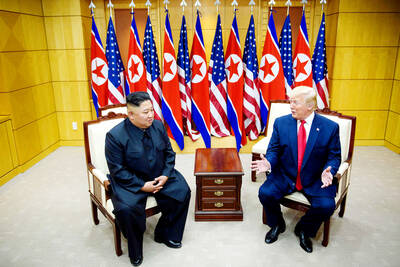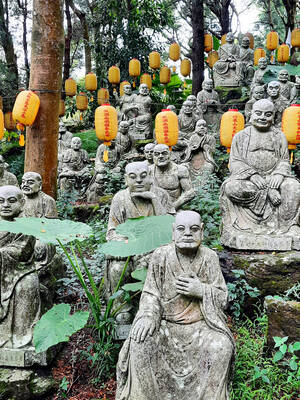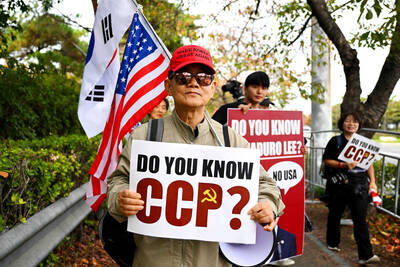Myth is protean. Whether in the context of politics or culture, it is constantly shifting and changing. An exhibit at the Taipei Fine Arts Museum (TFAM) attempts to capture the idea of myth in its artistic forms through the work of three artists.
Iris Huang (黃舒屏), the exhibit’s curator, has done a splendid job in selecting the artists and laying out the exhibition area. The artists are given their own separate spaces in Gallery D of the museum (in the basement level), but these spaces are near each other for the purpose of thematic cohesion.
Titled Mythology of Contemporary Art (當代藝術神話), the show investigates popular culture, history and archeology (real and invented) through the sculptures of two young Taiwanese artists, Tu Wei-cheng (涂維政) and Yang Mao-lin (楊茂林), and the paintings of New York-based Chinese artist Zhang Hong-tu (張宏圖).
Tu’s Aztec-like sculptures imitate the architecture and sculpture of an ancient civilization. The large stone slabs, bas-relief friezes and monumental steles deftly retain, through the use of color and material, the appearance of old artifacts.
The arrangement of the sculptures resembles an archeological museum’s exhibit, complete with photographs of the “excavation site,” a documentary about the civilization by “historians” and “archeologists” and a timeline of the excavation process. Dark walls, objects behind glass and spotlights beaming down on the works provide additional impact.
Stele No BM66 — Gate of the Fleeing Souls (BM66號石牆 — 魂遁之門人) illustrates Tu’s sculptural style and the civilization he continues to create. Two artificial stone steles stand in front of a large wall, the center of which is a circular tablet. Human figures in various positions, executed in bas-relief, serve as the plaque’s focal point, circular itself.
Upon closer inspection the tableau reveals a series of interlocking technological instruments. The small figurines of man and beast common to ancient cultures are conspicuously absent here. Instead we find keyboards, electric sockets, computer game consoles and other relics that hint that this ancient culture was similar to our own.
Zhang Hong-tu’s 12 paintings Re-Make of Ma Yuan’s Water Album (780 Years Later) (再製馬遠水圖 (780年之後)) also examine appearances and reflect on the passing of time. He explores the effects of human-made smog on the sky’s color and how these environmental changes might affect visual representation.
The oil on canvas works are based on the monochrome studies of water done by the Song Dynasty landscape painter Ma Yuan (馬遠) and informed by early modernist pictorial techniques.
Although Zhang is not an impressionist painter, these works suggest otherwise. The use of color in Re-Make of Ma Yuan’s Water Album — S(780 Years Later) (再製馬遠水圖 — S(780年之後)) could be taken from Claude Monet’s Impression, Sunrise. However, the oranges and yellows of Zhang’s sun are partially obscured, replaced by a murky purplish-gray — a visual alteration, Zhang suggests, that is due to air pollution.
Yang’s sculpture series adapts material and idols from Taiwan’s religious culture and supplants them with images taken from popular consumer culture. Superheroes such as Wonder Woman replace Buddhist icons such as Vajradhara; a Taoist altar becomes a pedestal at which society worships cartoon heroes; spiritual images transform into fairy-tale products that could be sold in the market place.
A Story About Affection — Beloved King Kong Vajradhara (有關愛情的故事 — 金剛愛金剛) presents a gorilla on a lotus leaf embracing a figure that looks like a mermaid. The sculpture suggests that people no longer project their yearnings onto spiritual idols, but that today cartoons and superheroes are the symbols by which people make sense of their lives.
Though many of these works have been seen before at different Taipei venues (Tu’s at a 2003 exhibit at MOCA, Taipei; Yang’s at the Madden Reality exhibit that just ended at TFAM), bringing them together in one show raises many interesting questions about the mythology of creation and observation, while avoiding the theoretical jargon that could have easily bogged down this very enjoyable exhibition.

US President Donald Trump may have hoped for an impromptu talk with his old friend Kim Jong-un during a recent trip to Asia, but analysts say the increasingly emboldened North Korean despot had few good reasons to join the photo-op. Trump sent repeated overtures to Kim during his barnstorming tour of Asia, saying he was “100 percent” open to a meeting and even bucking decades of US policy by conceding that North Korea was “sort of a nuclear power.” But Pyongyang kept mum on the invitation, instead firing off missiles and sending its foreign minister to Russia and Belarus, with whom it

When Taiwan was battered by storms this summer, the only crumb of comfort I could take was knowing that some advice I’d drafted several weeks earlier had been correct. Regarding the Southern Cross-Island Highway (南橫公路), a spectacular high-elevation route connecting Taiwan’s southwest with the country’s southeast, I’d written: “The precarious existence of this road cannot be overstated; those hoping to drive or ride all the way across should have a backup plan.” As this article was going to press, the middle section of the highway, between Meishankou (梅山口) in Kaohsiung and Siangyang (向陽) in Taitung County, was still closed to outsiders

President William Lai (賴清德) has championed Taiwan as an “AI Island” — an artificial intelligence (AI) hub powering the global tech economy. But without major shifts in talent, funding and strategic direction, this vision risks becoming a static fortress: indispensable, yet immobile and vulnerable. It’s time to reframe Taiwan’s ambition. Time to move from a resource-rich AI island to an AI Armada. Why change metaphors? Because choosing the right metaphor shapes both understanding and strategy. The “AI Island” frames our national ambition as a static fortress that, while valuable, is still vulnerable and reactive. Shifting our metaphor to an “AI Armada”

The Chinese Communist Party (CCP) has a dystopian, radical and dangerous conception of itself. Few are aware of this very fundamental difference between how they view power and how the rest of the world does. Even those of us who have lived in China sometimes fall back into the trap of viewing it through the lens of the power relationships common throughout the rest of the world, instead of understanding the CCP as it conceives of itself. Broadly speaking, the concepts of the people, race, culture, civilization, nation, government and religion are separate, though often overlapping and intertwined. A government